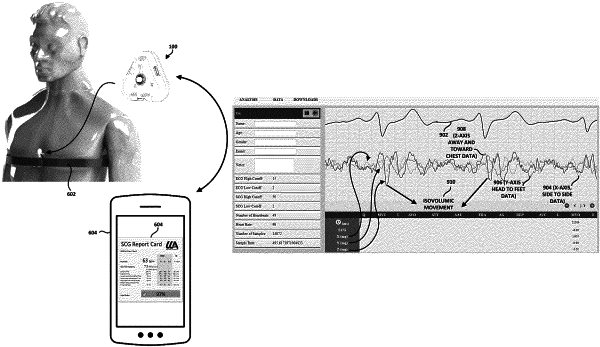| CPC A61B 5/341 (2021.01) [A61B 5/0022 (2013.01); A61B 5/02028 (2013.01); A61B 5/1102 (2013.01); A61B 5/259 (2021.01); A61B 5/349 (2021.01); A61B 5/7246 (2013.01); G06V 40/15 (2022.01); A61B 5/6831 (2013.01); A61B 2560/045 (2013.01); A61B 2562/0219 (2013.01)] | 12 Claims |

|
1. A computer-implemented method, comprising:
providing at least one wireless tri-axial seismocardiography (SCG) device configured to measure and time-stamp movements of a user's chest caused by the user's heart beats; the SCG device comprising a housing comprising a skin contact surface configured to contact skin of the user's chest and an outer surface disposed away from and facing away from the skin contact surface, a printed circuit board (PCB) disposed in the housing and configured to support and interconnect a processor, memory, a three-axis accelerometer module comprising an Inertial Measurement Unit (IMU), a communication module configured to communicate with the app on the mobile device and with the remote server over a computer network, a power source, and a time base;
using the provided at least one SCG device, carrying out at least one test for each of a plurality of users, each test comprising:
positioning the SCG device on the user's chest;
using the positioned SCG device, detecting, sampling, digitizing and time-stamping movement vectors of the user's chest over a period of time in each of x, y and z directions;
sending the time-stamped digitized movement vectors to a remote server over a computer network;
identifying, from the time-stamped digitized movement vectors, sharp changes in direction during isovolumic contraction time (IVCT) and isovolumic relaxation time (IVRT) as indicators of mitral or aortic insufficiency or stenosis;
identifying and storing, by the remote server, a set of fiduciary markers in each test using the time-stamped digitized movement vectors in each of x, y and z directions;
associating each the sets of fiduciary markers with one of the plurality of users,
subsequently testing of one of the plurality of users and generating a corresponding time-stamped digitized movement vectors;
generating a subsequent set of fiduciary markers using the corresponding time-stamped digitized movement vectors in each of x, y and z directions;
comparing the subsequent set of fiduciary markers generated during the subsequent test with the stored sets of fiduciary markers to identify at least one matching set of stored fiduciary markers; and
based upon the comparison of the subsequent and the stored set of fiduciary markers, uniquely identifying which of the plurality of users was subsequently tested as the user whose associated set of stored fiduciary markers at least partially matches the corresponding fiduciary markers generated during the subsequent test.
|